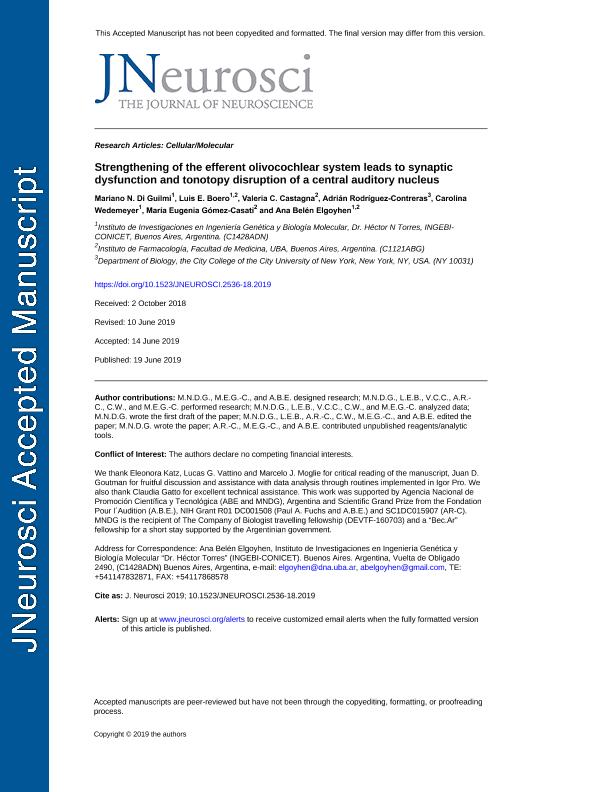Artículo
Strengthening of the Efferent Olivocochlear System Leads to Synaptic Dysfunction and Tonotopy Disruption of a Central Auditory Nucleus
Di Guilmi, Mariano Nicolás ; Boero, Luis Ezequiel
; Boero, Luis Ezequiel ; Castagna, Valeria C.; Rodríguez Contreras, Adrián; Wedemeyer, Carolina
; Castagna, Valeria C.; Rodríguez Contreras, Adrián; Wedemeyer, Carolina ; Gomez Casati, Maria Eugenia
; Gomez Casati, Maria Eugenia ; Elgoyhen, Ana Belen
; Elgoyhen, Ana Belen
 ; Boero, Luis Ezequiel
; Boero, Luis Ezequiel ; Castagna, Valeria C.; Rodríguez Contreras, Adrián; Wedemeyer, Carolina
; Castagna, Valeria C.; Rodríguez Contreras, Adrián; Wedemeyer, Carolina ; Gomez Casati, Maria Eugenia
; Gomez Casati, Maria Eugenia ; Elgoyhen, Ana Belen
; Elgoyhen, Ana Belen
Fecha de publicación:
06/2019
Editorial:
Society for Neuroscience
Revista:
Journal of Neuroscience
ISSN:
0270-6474
e-ISSN:
1529-2401
Idioma:
Inglés
Tipo de recurso:
Artículo publicado
Clasificación temática:
Resumen
The auditory system in many mammals is immature at birth but precisely organized in adults. Spontaneous activity in the inner ear plays a critical role in guiding this maturation process. This is shaped by an efferent pathway that descends from the brainstem and makes transient direct synaptic contacts with inner hair cells. In this work, we used an α9 cholinergic nicotinic receptor knock-in mouse model (of either sex) with enhanced medial efferent activity (Chrna9L9'T, L9'T) to further understand the role of the olivocochlear system in the correct establishment of auditory circuits. Wave III of auditory brainstem responses (which represents synchronized activity of synapses within the superior olivary complex) was smaller in L9'T mice, suggesting a central dysfunction. The mechanism underlying this functional alteration was analyzed in brain slices containing the medial nucleus of the trapezoid body (MNTB), where neurons are topographically organized along a mediolateral (ML) axis. The topographic organization of MNTB physiological properties observed in wildtype (WT) was abolished in L9'T mice. Additionally, electrophysiological recordings in slices indicated MNTB synaptic alterations. In vivo multielectrode recordings showed that the overall level of MNTB activity was reduced in the L9'T The present results indicate that the transient cochlear efferent innervation to inner hair cells during the critical period before the onset of hearing is involved in the refinement of topographic maps as well as in setting the properties of synaptic transmission at a central auditory nucleus.SIGNIFICANCE STATEMENT Cochlear inner hair cells of altricial mammals display spontaneous electrical activity before hearing onset. The pattern and firing rate of these cells are crucial for the correct maturation of the central auditory pathway. A descending efferent innervation from the CNS contacts the hair cells during this developmental window. The present work shows that genetic enhancement of efferent function disrupts the orderly topographic distribution of biophysical and synaptic properties in the auditory brainstem and causes severe synaptic dysfunction. This work adds to the notion that the transient efferent innervation to the cochlea is necessary for the correct establishment of the central auditory circuitry.
Palabras clave:
CHRNA9L9′T
,
EFFERENT MOC INHIBITION
,
MNTB
,
TONOTOPY
,
Α9Α10 NACHR
Archivos asociados
Licencia
Identificadores
Colecciones
Articulos(INGEBI)
Articulos de INST.DE INVEST.EN ING.GENETICA Y BIOL.MOLECULAR "DR. HECTOR N TORRES"
Articulos de INST.DE INVEST.EN ING.GENETICA Y BIOL.MOLECULAR "DR. HECTOR N TORRES"
Articulos(OCA HOUSSAY)
Articulos de OFICINA DE COORDINACION ADMINISTRATIVA HOUSSAY
Articulos de OFICINA DE COORDINACION ADMINISTRATIVA HOUSSAY
Citación
Di Guilmi, Mariano Nicolás; Boero, Luis Ezequiel; Castagna, Valeria C.; Rodríguez Contreras, Adrián; Wedemeyer, Carolina; et al.; Strengthening of the Efferent Olivocochlear System Leads to Synaptic Dysfunction and Tonotopy Disruption of a Central Auditory Nucleus; Society for Neuroscience; Journal of Neuroscience; 39; 36; 6-2019; 7037-7048
Compartir
Altmétricas



